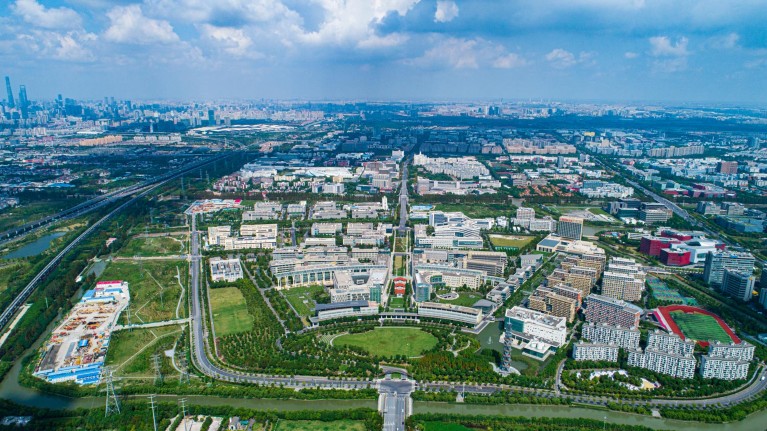
The vast ShanghaiTech campus is home to an extensive array of world-class research infrastructure.Credit: ShanghaiTech University
As China looks to become carbon-neutral, new opportunities arise in targeting the world’s largest population for cross-disciplinary research and teaching, according to Jie Yin, vice president and provost of ShanghaiTech University (ShanghaiTech).
Jointly founded by the Chinese Academy of Sciences and Shanghai Municipal People’s Government in 2013, ShanghaiTech has an embedded culture of research innovation to address global priorities in environmental and public health.
“Shanghai is home to the best ranked universities in China defined by scope and scale. At ShanghaiTech, success is about being the best in our areas of strengths. These are built upon our dedication to an open environment to promote independent research of real impact, and not just measured by the number and comprehensiveness of our programmes,” says Yin.
Photon science, for example, is one of the subjects with significant potential. Yin explains that the tradition of optics research in China runs deep, but its photonics development is relatively recent. “Developing photonic infrastructure could take a long time, and may not yield a sharp increase in number of papers, but such studies could shed light on green energy, serving national goals and the needs of the international scientific community,” he says.
Promoting photon science is one of ShanghaiTech’s academic priorities.Credit: luchschenF/Shutterstock
A growing cluster for photon science
At a global photon science research institution, Zhangjiang Comprehensive National Science Center in Shanghai, new facilities have been designed to study internal structure and dynamic changes of live cells and catalytic reactions at the femtosecond level (a quadrillionth of a second), to glean clues about the underlying mechanisms. Supported by national funding and state laboratories, ShanghaiTech has been a main player in each step from creating the blueprint for large-scale facilities, to coordinating their assembly.
A materials scientist by training, Yin explains that the Shanghai-XFEL Beamline Project (SBP) of the Shanghai Soft X-ray Free Electron Laser Facility (SXEFL) could allow researchers to view catalysts in continuous motion at the molecular level.
“Many catalysts work at high-temperature, high-pressure conditions that require substantial energy expenditure. With SXEFL, we re-examine catalyst design to reduce byproducts and reaction requirements, thereby minimizing environmental pollution,” says Yin.
SXEFL, working at wavelengths as short as 2.0 nanometres, also holds great promise for viewing biological specimens and organic molecules in their natural aqueous environment, such as in live cell imaging. In June 2021, ShanghaiTech announced SXEFL’s full coverage of the ‘water window’, an electromagnetic spectrum where oxygen and water are transparent to soft X-rays, which are absorbed by other building blocks of life such as carbon and nitrogen.

Synchrotron radiation facilities drive quantum studies, including the development of potential quantum materials.Credit: Jurik Peter/Shutterstock
This series of infrastructure developments, with plans extending to 2025 and beyond, include the Shanghai Superintense Ultrafast Laser Facility (SULF), the Shanghai HIgh repetitioN rate XFEL and Extreme light facility (SHINE), and the Shanghai Synchrotron Radiation Facility (SSRF). SSRF hosts the Nano Angle Resolved Photoelectron Spectroscopy (NanoARPES), the first of its kind in China, designed and developed by ShanghaiTech. Now operational, the station will enable X-ray photons to focus on an extremely small solid sample via synchrotron radiation, thus helping to detect electronic structure and advance studies on low dimensional and quantum materials.
“These facilities welcome not only ShanghaiTech staff and students, but also researchers from other parts of China and the world,” adds Yin.
Innovations from the inside out
Along with the teaching and research opportunities designed around new infrastructure, Yin points to national support for land acquisition, campus expansion, as well as other financial investments. There is academia-business synergy in its Zhangjiang neighbourhood that has encouraged a growing number of start-ups and multinationals specializing in emerging fields and crossroads of science.
The faculty structure at ShanghaiTech reflects this need for increasing collaboration, such as materials science, information engineering, and public health, defying traditional categorization to flexibly tackle translational complexities.
“While the impact of our materials science innovations sees potential to reach other branches of basic science including physics and chemistry, similarly, an increasing number of our projects in immunology and biomedical engineering demonstrate the potential for clinical studies,” says Yin. “These could benefit from our new infrastructure and network of national research facilities across Shanghai.”
There is also a push for young researchers to take centre stage, which for Yin, could mean taking a step back to reform the traditional top-down approach towards academic planning and resource allocation.
“Younger researchers may lack access to funding and other support compared to their senior peers, and China is not alone in this problem,” he says. “But we have devoted greater attention to an inclusive environment and a support system to encourage long-term personal growth, together with a shift of emphasis from knowledge transfer to skill building.”
Securing the funding and having the infrastructure in place are essential, but he also sees the value of effective institutional structure and incentives. Yin wants to ensure an open environment with enough room for researchers to explore their interests, while taking responsibility for their career path. Students are encouraged to take initiative in starting their own projects and working together on international competitions.
After all, strength of ShanghaiTech, he believes, stems not only from its world-class facilities, but its talent. “We’re here to support them all the way by offering them world-class resources and all the guidance they need.”


